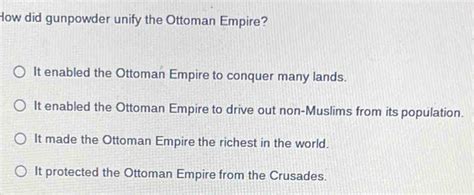In the tapestry of history, the Ottoman Empire stands out as a formidable force that ruled over vast territories for centuries. Its military prowess and territorial expansion were fueled in no small part by the transformative power of gunpowder. This remarkable invention not only revolutionized warfare but also played a pivotal role in shaping the Ottoman Empire’s destiny.

The Genesis of Gunpowder
Gunpowder, a potent mixture of sulfur, charcoal, and saltpeter, originated in China during the 9th century. Its explosive properties were initially harnessed for recreational purposes, such as fireworks and firecrackers. However, by the 13th century, gunpowder had found its way to the Eurasian steppes and eventually reached the Ottoman Empire.
Gunpowder in the Ottoman Military
The Ottomans quickly recognized the immense potential of gunpowder in warfare. They established dedicated arsenals and foundries to produce firearms and munitions. By the 15th century, the Ottoman army had become a formidable force, equipped with siege cannons, muskets, and other advanced weaponry.
Siege Warfare
Gunpowder revolutionized siege warfare. Before the advent of cannons, laying siege to a fortified castle or city could take months or even years. With gunpowder artillery, however, defenders could be bombarded from afar, weakening walls and structures. This allowed the Ottomans to capture fortified strongholds with greater ease and efficiency.
Key Statistics:
- During the siege of Constantinople in 1453, the Ottomans deployed a massive cannon known as the “Basilica,” which fired cannonballs weighing over 1,500 pounds.
- The Ottomans used gunpowder artillery to conquer Rhodes in 1522 and Belgrade in 1521, demonstrating the devastating power of their siege warfare.
Field Warfare
Gunpowder weapons also transformed field warfare. Muskets, which could be fired from a distance, allowed the Ottomans to engage enemies from a safe distance. This tactical advantage provided them with a significant edge on the battlefield, enabling them to defeat larger armies with greater firepower.
Key Statistics:
- The Ottoman army fielded over 100,000 muskets by the late 16th century, making it one of the largest and most advanced firearms-equipped armies in the world.
- The Ottoman victory at the Battle of Mohacs in 1526 was largely attributed to the effectiveness of their musketry, which decimated the Hungarian cavalry.
Gunpowder’s Impact on Ottoman Expansion
Gunpowder not only bolstered the Ottoman military’s capabilities but also played a significant role in the empire’s territorial expansion.
Conquest of Anatolia
In the 14th century, the Ottomans used gunpowder artillery to conquer the Beyliks (small principalities) of Anatolia. By the early 16th century, they had established a firm foothold in the region, providing a strategic base for further expansion.
Expansion into Europe
Gunpowder-equipped Ottoman armies crossed the Balkans and captured major cities such as Belgrade, Budapest, and Vienna. The use of siege cannons and muskets allowed them to overcome formidable fortifications and defeat Christian forces.
Control of the Mediterranean
The Ottomans used gunpowder weaponry to establish naval supremacy in the Mediterranean Sea. Their fleets, equipped with cannons and other firearms, engaged and defeated European rivals, securing control of vital trade routes and expanding Ottoman influence in North Africa.
Conclusion
The advent of gunpowder in the Ottoman Empire was a transformative event that fundamentally altered the course of history. It revolutionized warfare, giving the Ottomans a decisive edge over their opponents. Gunpowder enabled them to conquer vast territories, establish a vast empire, and become a major player in global affairs. The Ottoman Empire’s success provides a compelling example of how technological innovation can fuel military power and territorial expansion.
Frequently Asked Questions (FAQs)
-
When did the Ottomans first acquire gunpowder weapons?
– The Ottomans acquired gunpowder weapons in the early 14th century. -
What was the main advantage of gunpowder artillery in siege warfare?
– Gunpowder artillery allowed the Ottomans to bombard fortified walls from a distance, weakening them and facilitating capture. -
How did gunpowder influence Ottoman naval warfare?
– Firearms equipped on Ottoman ships gave them naval supremacy in the Mediterranean, enabling them to defeat European rivals and control vital trade routes. -
What was the impact of gunpowder on Ottoman territorial expansion?
– Gunpowder played a crucial role in Ottoman territorial expansion, allowing them to conquer vast territories in Anatolia, Europe, and North Africa. -
What was the largest cannon used by the Ottomans?
– The largest cannon used by the Ottomans was the “Basilica,” which fired cannonballs weighing over 1,500 pounds. -
How many muskets did the Ottoman army field by the late 16th century?
– The Ottoman army fielded over 100,000 muskets by the late 16th century. -
What was the name of the Ottoman firearm that had a range of up to 400 meters?
– The Ottoman firearm with a range of up to 400 meters was the arquebus. -
True or False: Gunpowder was originally developed for military purposes.
– False. Gunpowder was initially developed for recreational purposes such as fireworks.
